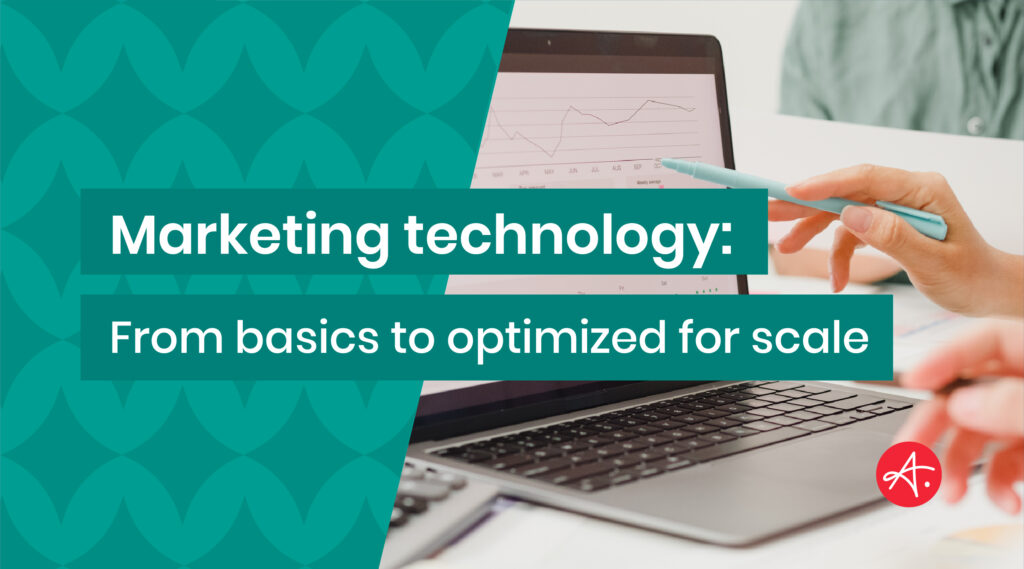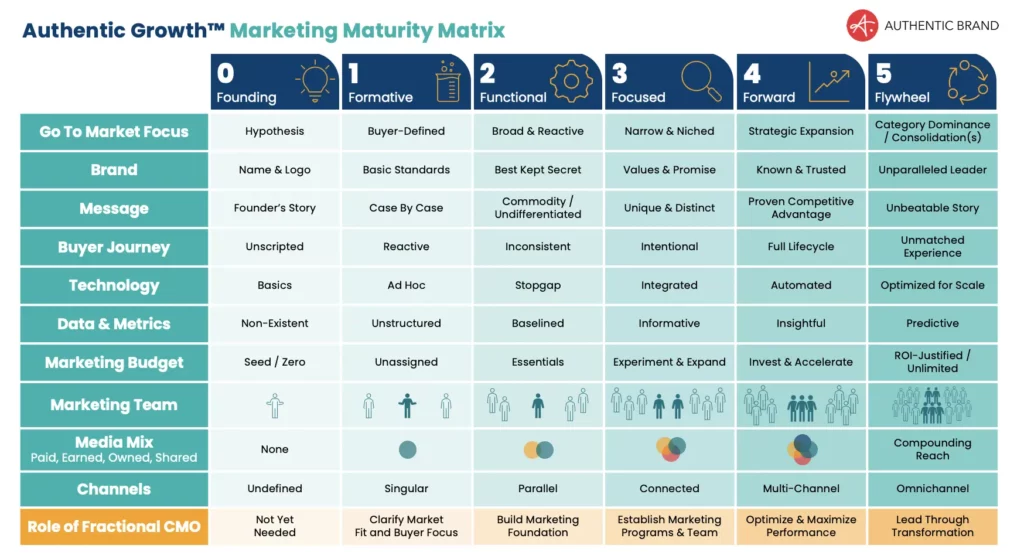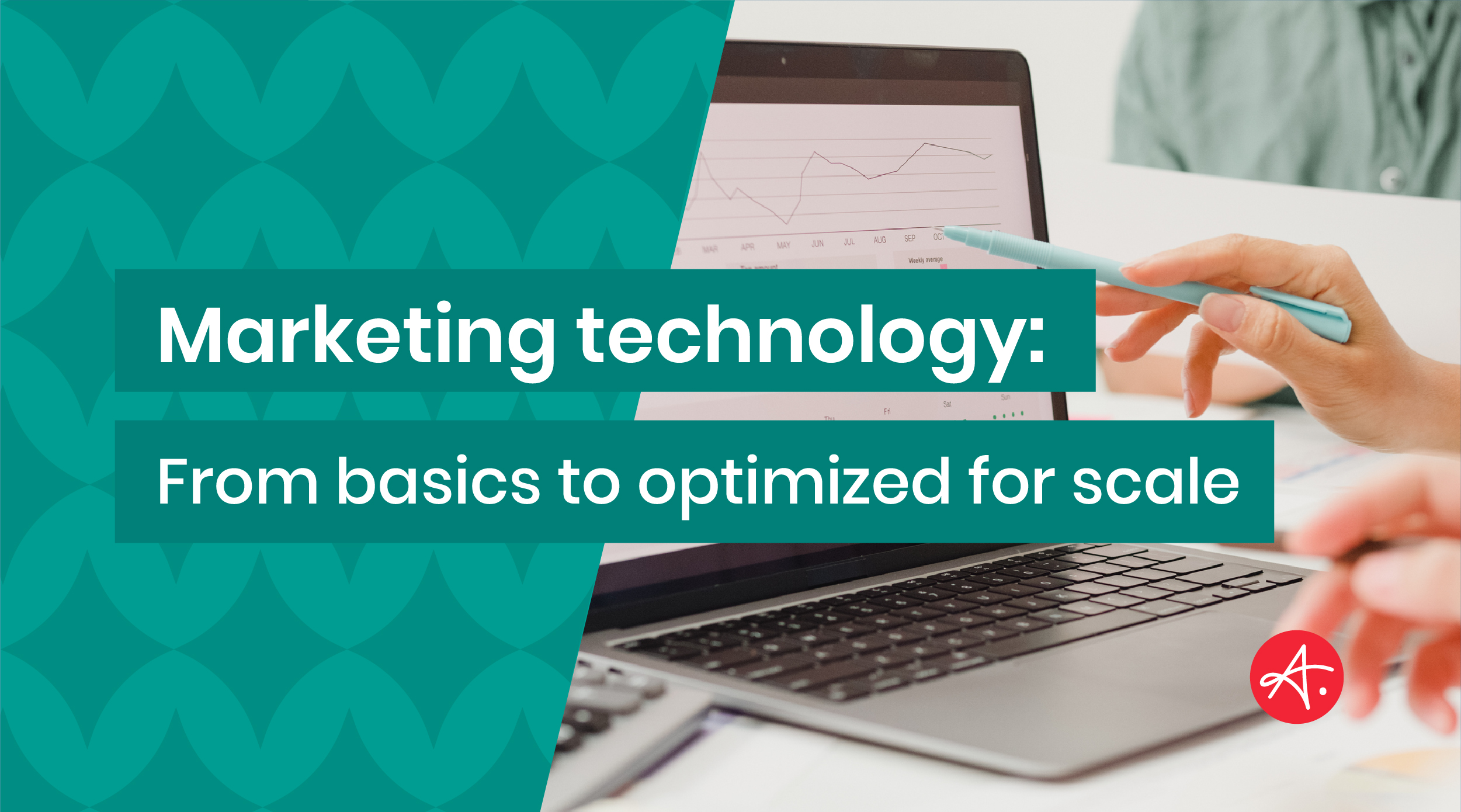
Marketing technology is a fast-evolving landscape
The role of a marketing leader has changed dramatically in recent years. What once was a role focused on brand, communications, creative, and advertising has expanded to include the ability to navigate a technology landscape that continues to grow exponentially and change rapidly.
Marketing leaders have to make sense of this vast landscape to create a marketing technology stack that supports their unique business objectives and growth stage. The good news is that leaders don’t need to tackle it all at once. Starting with the essentials and building from there is the easiest and wisest path to building a strategic marketing stack that can evolve and scale as the business does.
To help our clients make thoughtful and strategic technology decisions that support business growth, we use our Authentic Growth® Marketing Maturity Matrix. With our matrix, we help growing businesses think first about how they can enable engagement with their ideal audiences and create a framework for scaling with the right technology solutions.

The path to scalable technology: Stages 0 to 5
Building a fully optimized marketing technology stack requires a significant investment of resources — including time. Businesses should not expect or plan to mature from their basic technology foundation to a cohesive martech program quickly. Instead, marketing technology requires thoughtful and strategic decisions about what solutions your business needs to support its vision and develop deep relationships with the audiences who matter most to it.
The following six stages demonstrate how a company moves through this progression.

Stage 0: Founding – Basics
In the earliest days of a business, marketing technology needs are typically bare bones and basic. Your business model and product or service offering will dictate your needs. But for most companies, the first martech solutions required are those that enable foundational communication and help legitimize the business. For example, you will likely need a website, an email address with a branded domain, a Google business listing, and maybe one or more social media channels with branded handles.
How to mature to the next stage: Now is the time to implement your first-generation customer relationship management (CRM) solution to capture contact information and interactions. Businesses without CRMs miss out on valuable data that gives them baseline insights that further clarify their go-to-market focus and influence how they can grow and scale effectively. A CRM is so important that we might even go as far as saying that if you don’t have one, we’re not sure you are ready to start and grow a business.
What you’ll need: Invest in the resources and tools that establish your basic technology framework. For example:
- Explore lower-cost CRM solutions that allow you to gather basic data for contact and deal management.
- Consider hiring a search engine optimization expert to help you choose a web platform and build your website with SEO considerations in mind.
- Hire a freelance, experienced copywriter to fine-tune your website messaging and incorporate SEO copywriting best practices.

Stage 1: Formative – Ad Hoc
At this stage, your business is off the ground, and you have a fledgling online presence and CRM to manage relationships. You’re also likely experimenting with different marketing channels and tactics to identify which best support your business model and are feasible to execute with your existing resources.
With this marketing experimentation, you are likely adding new martech tools that enable you to execute these marketing tactics. And if you’re like most businesses, you will soon have a laundry list of standalone solutions for design, blogging, email marketing, video production and editing, website analytics, and more.
How to mature to the next stage: Start to standardize and document your martech stack. It’s never too early to start this documentation, and it will save you headaches down the line.
A common problem growing businesses face is that their various martech solutions have different owners or are set up under an individual instead of a company account. For example, some tools may have been initiated or paid for by an agency partner, freelancer, business founder, or staff member. Access and ownership become scattered, and when there is a change in roles, there’s a risk that you’ll lose access to your tools and the data or content they house.
What you’ll need: Audit your martech toolset to ensure you (the business or the owner) are the owner or administrator on every account. Document and protect your master account logins. If there are tools that you used early on that are no longer relevant, close those accounts to keep your martech stack as simple and streamlined as possible and to guard against extra fees that aren’t adding value to your business. Of course, before closing any account, make sure you’ve first migrated any essential data or content.

Stage 2: Functional – Stopgap
Your essential martech stack is now in place and working for your current programs. In addition to a CRM, you might have a website with regular content or blogs, an email marketing platform to distribute content to your subscribers, and one or more social channels to share content.
You may also have some basic integrations through forms on your website and some initial workflows or automation. But overall, your tech stack is likely siloed; your systems don’t talk to each seamlessly, and you don’t have a 360-degree view of your customers and how they engage with your brand. And if you’re like most businesses at this stage, you don’t have a truly strategic marketing plan to help you make wise decisions about how to leverage or evolve your technology to deliver the greatest value.
How to mature to the next stage: If you haven’t already, it’s time to add strategic rigor to your marketing programs. All the martech in the world isn’t going to help grow your business unless you direct your marketing activities toward the right audiences, with the right messaging, and at the right time in a way that builds trust with your brand.
Many businesses fall into the trap of random acts of marketing at this stage, doing more marketing activities in hopes that they’ll create more engagement with buyers. But often, this random approach backfires, as audiences are increasingly disengaging and unsubscribing from the onslaught of low- or no-value marketing. They don’t want more; they want higher value.
What you’ll need: Now is the time to invest in strategic marketing if you haven’t already. An experienced advisor or fractional CMO can help you evaluate your current programs, tech stack, and marketing spend to align all of these efforts. As you build maturity in your business, it’s critical that your marketing technology supports your business vision and creates value. An experienced marketing leader can help you evaluate the ROI of your technology and help you feel more confident about where you’re placing your bets.

Stage 3: Focused – Integrated
If you’ve advanced to this stage, your marketing strategy is now helping inform your martech investments. The clarity you’ve achieved with your buyer’s journey has helped you narrow down the channels through which you engage with your buyers and naturally leads you to the martech solutions that help you create and manage your audiences’ brand experience.
You’ve also likely eliminated some low-value channels and tactics you previously used and redirected your resources to higher-value channels. For example, your social media presence may have narrowed to focus on your highest-engagement channels, or you may have replaced a standalone email marketing platform with a marketing automation tool.
How to mature to the next stage: You’re ready to use your marketing technology much more strategically: not just to execute various marketing activities but also to truly support the buyer’s journey and brand experience with your stakeholders.
It’s time for your martech stack to shift from tactic-driven to relationship-driven. Getting to the next level of sophistication requires thoughtful experience design and system automation so the right people are receiving the right engagement from your brand, at the right time, in a way that feels personal and valuable.
What you’ll need: A plan to migrate from products that address one single challenge or use case to solutions that connect to support a cohesive brand experience. You’ll also need guidance from experts who can help you do all of this effectively.
Expert guidance is critical at this stage because there’s no easy button for marketing automation. In addition to an understanding of the tool itself, you need expertise in sales and marketing operations and campaign and content architecture. An experienced CMO can help lead this entire process: system implementation, operational, campaign, and automation improvements, and selecting the right agency partners to support your initial martech setup and ongoing customization as you build out campaigns and workflows.
The ability to choose the right partners is a critical strategic skill; your business requirements should drive which partners you choose, not the other way around. Working with an experienced marketing leader who has helped businesses implement and adopt these technologies is a good way to reduce risk and increase the odds of success.

Stage 4: Forward – Automated
By now, you’re using a good portion of your martech stack’s capabilities and designing your marketing program around your targeted personas. With these tools, you can test and measure each campaign and content piece’s performance to continue to fine-tune the value you bring to your audiences. And you continue to identify elements of your process that can be made more efficient and effective through automation.
How to mature to the next stage: The work to maintain an integrated, automated martech stack is never done, and it’s important that you continue to sustain a healthy automated system as you grow and scale.
It’s also important that no automation is left to run without oversight. With every new piece of content, initiative, or campaign, there is additional setup, testing, refinement, and management that will need to occur. In particular, you need to manage the volume of “touches” to your audience and manage against the risk of misfiring with outdated content or untimely messaging.
Be especially mindful when you have significant changes to your business or the markets you serve. For example, if you move into a new international market, are acquired, or acquire other entities. These pivotal moments of scale impact your martech stack and marketing strategy. Data and privacy rules and laws vary from country to country, and a misstep can damage your brand reputation or much worse.
Mergers and acquisitions often include integrating martech stacks and marketing capabilities. Integration can be a monumental effort when two companies have been operating on different platforms or even the same platforms configured differently. It’s so important to ensure that critical data, assets, and processes are protected and preserved through this process.
What you’ll need: Marketing leadership is critical at this stage. This leader should help you critically assess your current martech solution set and how it will need to evolve to support your business’s next phase of growth. Experienced marketers can help you determine what’s mission-critical, create a plan that preserves your critical data and streamlines your systems to create new efficiencies.
When doing martech migrations, a marketing leader can keep the rest of the leadership team aligned on expectations, pace, and updated on progress so the team doesn’t overlook any critical steps.

Stage 5: Flywheel – Optimized for scale
The marketing technology landscape will continue to evolve and expand, especially as AI has immediate and profound effects. And with all the new solutions yet to come, there will be a temptation to chase the newest shiny object. Plus, the bigger your business gets, the more vendors will be coming at you with new shiny solutions that promise the world, and the more people come into the organization wanting to make change just for the sake of making change.
Due diligence and referring to your business purpose and vision only become more critical at this stage. Answers to these questions matter as you make enterprise-level decisions about martech: What’s our business vision and purpose? Who matters to us? How do we reach those people in their natural habitat? Does this technology solution support all of that?
How to continue maturing: Understand that even maturity changes over time. Things like mergers and acquisitions and global marketplace changes impact organizations. As your industry, the world, and buyer expectations change, revisit your overall business growth strategy and how the marketing strategy supports it.
Recognize that a marketing strategy is never done, and use data to make informed decisions about how to refine the mix of your programs, people, and budgets. Focus on building strong relationships with IT and legal to improve the process of vetting or retiring technology solutions.
What you’ll need: Thoughtfully monitor trends and competitive dynamics to challenge your own assumptions about your business. Ensure you have strong feedback loops in place that give you indicators of what’s happening in your relevant segment of the world.
Optimizing your technology for scale requires thoughtful planning
There is no other segment of marketing that costs as much or has the potential to waste as much money, time, and resources as marketing technology. Martech is expensive, and it requires businesses to be thoughtful about the investments they make. This is also why having an experienced strategic marketer is so important for companies undergoing marketing technology changes.
Authentic Fractional CMOs™ have deep experience helping growing companies avoid random acts of marketing technology to make strategic investments into solutions that support strong relationships and generate business value. If you are feeling the growing pains of marketing technology, now would be a good time to get in touch with us to discuss what fractional marketing leadership could look like in your business.








